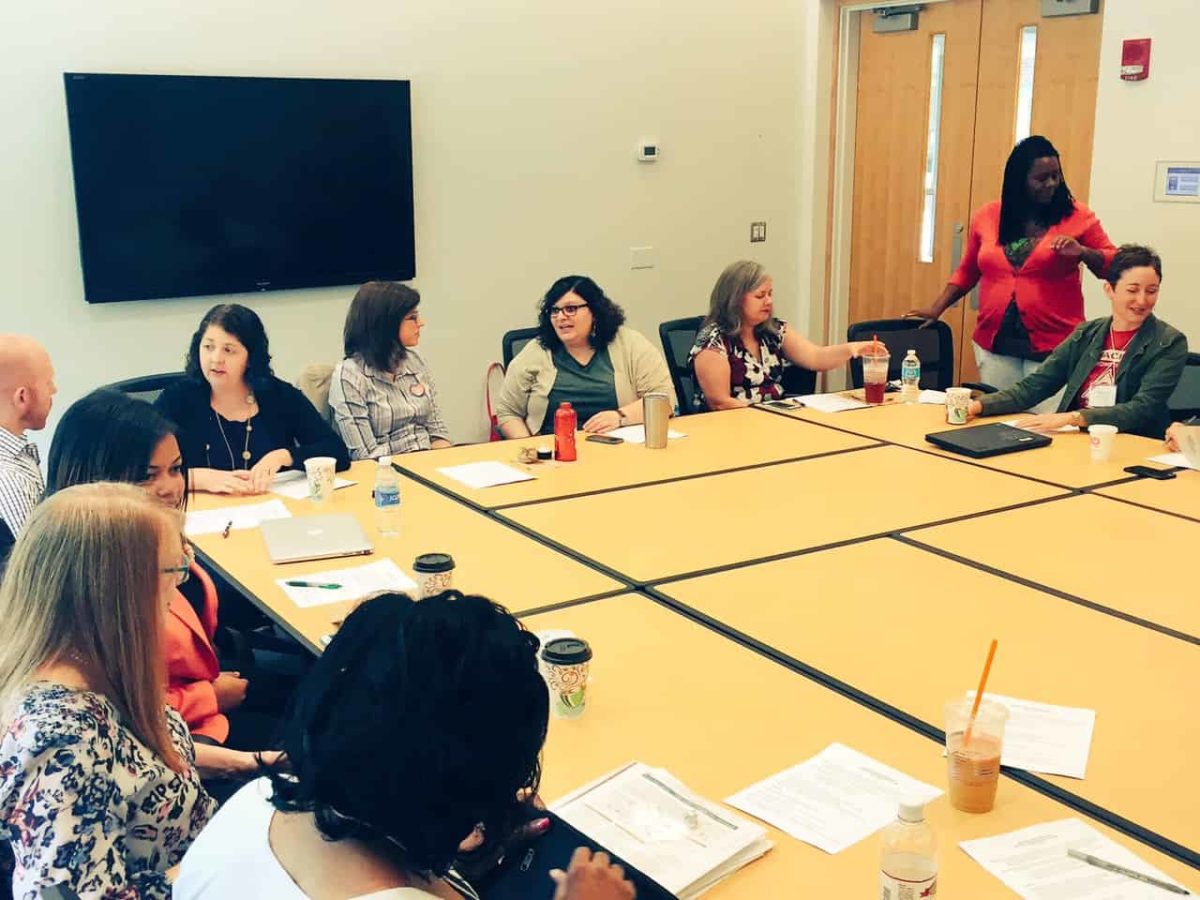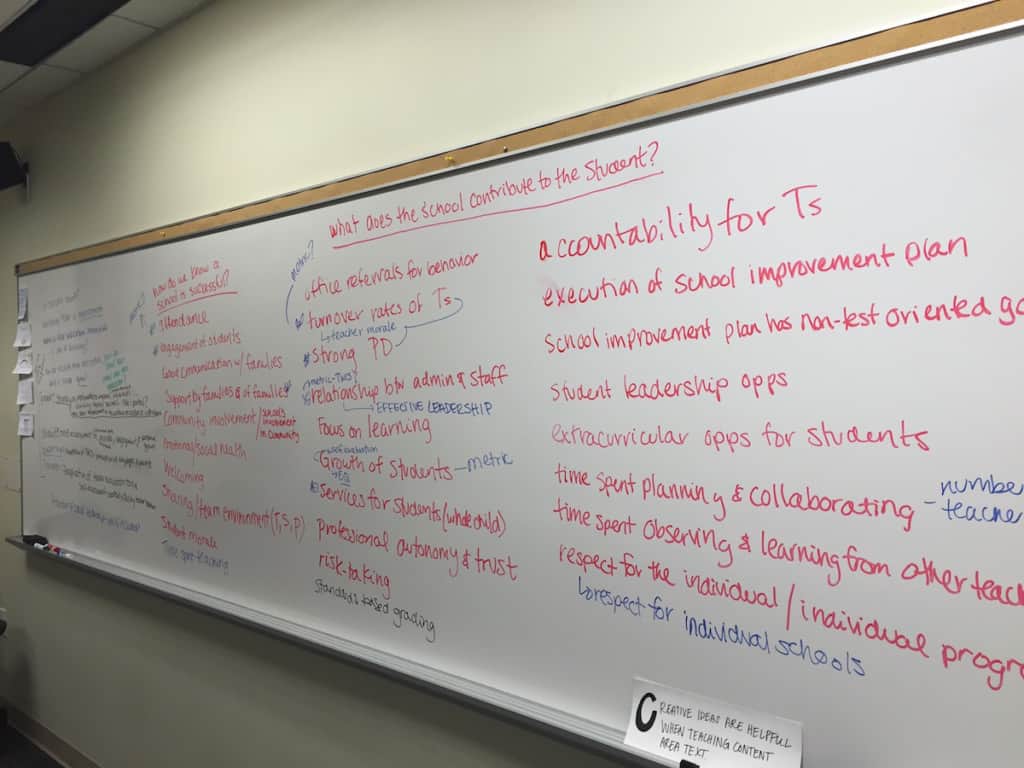

The comments below were aggregated by the Hope Street Group North Carolina Teacher Voice Network through a series of teacher engagement events. They were submitted to the North Carolina Department of Public Instruction on May 24, 2016 as feedback on the state’s Every Student Succeeds Act (ESSA) plan. If you have feedback to share, visit: http://www.dpi.state.nc.us/newsroom/lets-talk/
Introduction
On May 12, 17, and 21, the Hope Street Group North Carolina Teacher Voice Network both physically and virtually convened teachers from across the state to discuss school accountability under the new Every Student Succeeds Act. This document aggregates the feedback received during those interactions, providing both summary recommendations and an appendix of comments provided. In total, more than 60 educators directly informed the comments in this report.
Teachers in both meetings were moved by the question “What does the school provide to the students?” when evaluating measurements of school accountability. This question was prompted by the recent Brookings Institute piece, “New school accountability measures must be careful not to reinforce student poverty.” Moreover, teachers self-guided their conversations taking into account the school’s ability to use the indicators to improve the school environment.
Summary
K-8
Teachers at the K-8 level from New Hanover County, Brunswick County, and Pender County determined that non-academic measures of school accountability should fall in one of four categories: Parents, Students, Leadership, and Teachers. Furthermore, these indicators should ultimately–though perhaps more subjectively–demonstrate a love of learning within the school.
School performance as it relates to parent involvement should be measured according to the strategies a school implements to improve non-excused student absences, including support services. These strategies could be tracked similarly to the tracking processes in the “Title I Portal” used at select schools. To confirm the efficacy of these strategies, this metric should be looked at in concert with an improvement or maintenance of excellence in student attendance.
Student engagement should also be tracked using a self-assessment of morale, engagement, and personal growth at the school. While this may differ in content from the student survey initiative organized by NCDPI, the two could be reconciled to produce one report achieving both a picture of student engagement and educator effectiveness.
The measurement of leadership can be achieved by adapting elements of the Teacher Working Conditions Survey to evaluate the perception of staff at the school. Important aspects to measure would include: relationship between administrators and staff; professional autonomy and trust; time spent planning and collaborating; and time spent observing and learning from other teachers.
As the Teacher Working Conditions Survey may be adapted to provide non-academic metrics for school performance, the current Teacher Evaluation Tool may be reapplied to measure the performance of teachers at a school. If combined with a greater self-assessment of morale, engagement, and personal growth (as with students), the validity of these measurements should be substantiated by teacher turnover rates in the school.
All Levels/High School
Educators at the May 21 meeting (representing Durham, Harnett, Cumberland, Orange, and Wake Counties, in addition to charter schools) were primarily from the high school level and their conversation encompassed the entire school continuum.
Five overarching ideas were agreed upon, stemming from an idea that the school’s purpose is to grow and educate the “whole child”:
Teacher performance
Discipline
Course enrollment and diversity
Support services provided families and students
Application of the Teacher Working Conditions Survey
Similar to the group’s conclusions on May 12th, teacher performance as evaluated by a reapplication of the Teacher Evaluation Tool was discussed. The Teacher Evaluation Tool would point to two important aspects of school performance: the use of evidence based best practices for instruction and the availability and effectiveness of quality professional learning. Student growth would be incorporated into this measurement process.
While “office referrals for behavior” was mentioned during the discussion with elementary level teachers, the second group dove deeper and decided that evidence of an “educated discipline policy” was an important metric. This metric would be demonstrated through office referrals, recidivism, and an evaluation of the school’s MTSS/PBIS results.
The diversity (across demographics and intellectual ability) of students enrolled in a school’s course offerings also emerged as a priority metric at the high school level. This measurement would demonstrate a school’s commitment to closing the achievement gap, applying an educated disciplinary policy, and teaching the individual child. Furthermore, including a measurement on the breadth and depth of course and activity offerings would indicate a high level of student, teacher, and parent engagement and, in some cases, community involvement. A high level of AP and CTE course offerings would point toward a school interested in the college and career success of each of its students.
A focus on the support services provided by the school to families and students was a clear commonality between both in-person groups of teachers. Support services would include: guidance counselors, ESL instructors, translators, school nurses, psychologists, and support for pre-K to kindergarten and kindergarten to first grade transitions. These support services would be correlated based on the needs of the school. The provision of support services would need not be a standalone measurement: it would or could be tied to another data point addressing the growth or engagement of students (and/or parents).
Lastly, the Teacher Working Conditions Survey was again mentioned as an “easy” way to measure important qualities like teacher engagement, teacher morale, and the relationship between administrators and staff.
Twitter Chat Themes
Five questions were discussed during May 17’s statewide Twitter Chat:
What are the public’s expectations from NC’s public schools?
What school characteristics are the most important?
How should school success be measured?
How does North Carolina ensure that all schools are successful?
How should North Carolina recognize and celebrate school success?
The following themes emerged (arranged according to question):
What are the public’s expectations from NC’s public schools?
- High-quality, professional teachers
- Reliable measurements of student progress
- To prepare the next generation of work-ready problem-solvers to tackle problems in our communities
- Strong student performance
- High graduation rates
- Students that are inspired and excited to learn
- Challenging curriculum
- That North Carolina schools are on track with the rest of the United States and other countries
- Schools to pull together and ensure that students learn and grow regardless of changes in resources and expectations
- Teach all students regardless of level or background
- Schools that are safe where students are valued
What school characteristics are most important?
- Safety is the most critical (physical and emotional)
- Adept, productive, responsive leadership; cultivation of a community of learners; productive education environment
- Highly trained, caring staff capable of teaching every child
- Engage the community, support growth mindset, engage/inspire both students and teachers
- Shared vision, shared leadership, shared passion, and shared excellence
- Respect of the whole child–academics, social, emotional, physical
- Clarity of learning goals, strategies, and expectations for students–shared focus of all adults in the school
- Student engagement academically and socially
- Positive attitude of staff, mix of new and veteran teachers, and faculty is empowered and involved
- Student’s academic growth
- Foster creativity, independence, critical thinking, and problem solving
- Communication with stakeholders
- Strong leadership and positive relationship between administrators and staff
How should school success be measured?
- High quality assessment, teacher retention, parent engagement
- Focus on measuring teachers, including turnover rates
- Holistically, through things like observations and site visits
- Course pass rates
- Graduation rates
- Student growth
- Student attendance
- It should not be measured by test scores, graduation rates, or parent/student surveys
- Proficiency and growth measures that account for poverty and other outside factors
- Success at the next level (middle school for elementary; college/career for high school)
- Discipline reports
- Teacher/staff morale
- Curriculum implemented and instructional practice
How does North Carolina ensure all schools are successful?
- Ensure all schools have the same qualifications, expectations, and access to materials
- High quality assessments
- Meaningful professional development for all teachers
- Make sure teachers and principals everywhere are paid as professionals
- Support policies that lead to high-quality teacher recruitment/retention and professional growth opportunities
- Use Teacher Evaluation Process rubric as formative evaluation paired with coaching for improvement of instruction
- Help from local school boards to hold schools accountable
- Equal funding to eliminate “poor” schools and “rich” schools
- Small class sizes
How should North Carolina recognize and celebrate school success?
- Talk more about the success of our public schools and how they can be supported
- Funding to enhance learning
- Better salaries
- Incentives for long term commitment to a school
- Help other schools learn from successful schools
- Recognize schools closing achievement gaps
- Reward teachers with trust and respect (increased autonomy)
- Reward them with what they need to reach their next level (equipment, professional development, technology, travel)
- Award student and teacher scholarships


Hope Street Group)
Conclusions
While narrowing down school performance indicators–particularly non-academic indicators–was a challenge for each group of educators, the commonalities between discussions show a preference for measurements directly within the school or district’s control regardless of resources and with which the broader picture of the school as a learning environment could be demonstrated.
As you will see in the appendix, educators in all three conversations also diversified their focus on students, teachers, and administrators, and to a lesser extent parents and the community.
Educators also referred frequently to measurement processes already in place that could be adapted, more closely followed, or reapplied to a new purpose for the sake of the Every Student Succeeds Act. Most frequently, these processes were the Teacher Evaluation Tool and the Teacher Working Conditions Survey.
Finally, it was common that an objective measurement–student attendance, for example–was asked to be combined with another measurement–support services provided, in this case–to provide the clearest picture of a school possible, account for what is in the school’s control, allow for the measurement to be used to encourage progress, and equalize the measurement across the state.


